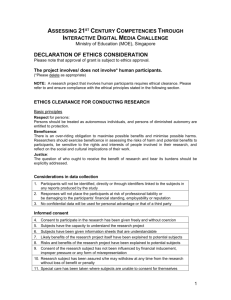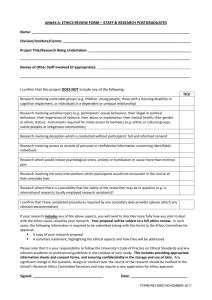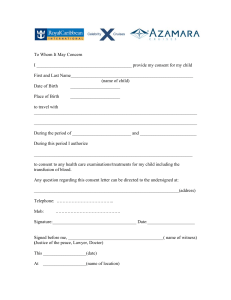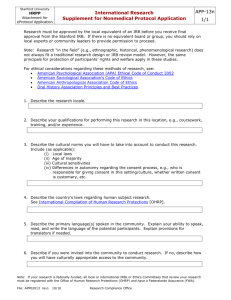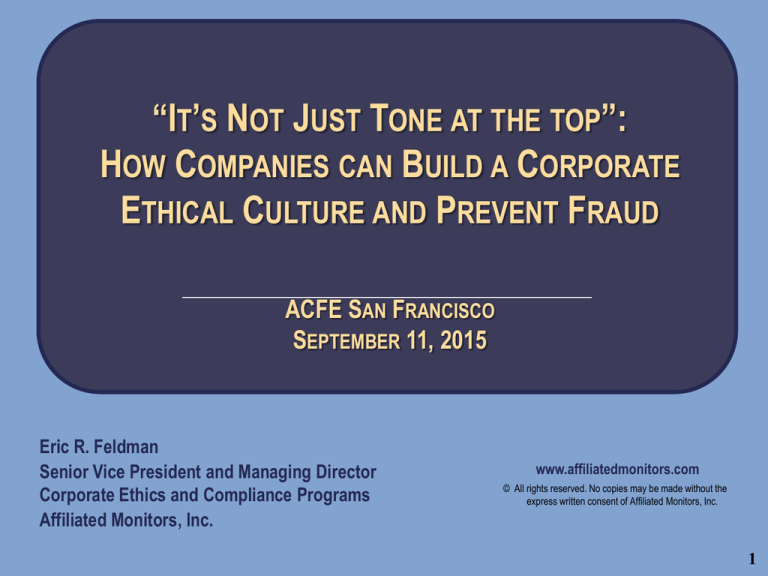
“IT’S NOT JUST TONE AT THE TOP”:
HOW COMPANIES CAN BUILD A CORPORATE
ETHICAL CULTURE AND PREVENT FRAUD
ACFE SAN FRANCISCO
SEPTEMBER 11, 2015
Eric R. Feldman
Senior Vice President and Managing Director
Corporate Ethics and Compliance Programs
Affiliated Monitors, Inc.
www.affiliatedmonitors.com
© All rights reserved. No copies may be made without the
express written consent of Affiliated Monitors, Inc.
1
Retired from CIA in April 2011 with 32 years of federal
service
Government Accountability Office
Department of Defense
CIA/National Reconnaissance Office IG
Senior Advisor for Procurement Integrity
Different perspectives on business ethics:
senior agency official, law enforcement, corporate
consultant, independent monitor
© All rights reserved. No copies may be made without the express written consent of Affiliated Monitors, Inc.
2
© All rights reserved. No copies may be made without the express written consent of Affiliated Monitors, Inc.
3
Code of
Conduct
Code of
Ethics
Policies and
Procedures
© All rights reserved. No copies may be made without the express written consent of Affiliated Monitors, Inc.
4
ETHICS
VS
COMPLIANCE
© All rights reserved. No copies may be made without the express written consent of Affiliated Monitors, Inc.
5
Largely rule-based
“SOX” Code of Conduct
2008 Economic Meltdown
© All rights reserved. No copies may be made without the express written consent of Affiliated Monitors, Inc.
6
“Some companies have given up entirely on trying to figure
out what’s ethical and are instead using what’s legal as their
standard for decision-making…the result is moral
bankruptcy.”
–Kevin Rollins, president
Dell Computer Corporation
© All rights reserved. No copies may be made without the express written consent of Affiliated Monitors, Inc.
7
Ruling Philosophies:
“As long as it’s legal, it’s ethical.”
“As long as it’s not illegal, it’s okay.”
“If you can’t look yourself in the mirror for
something you’re about to do, don’t do it.”
-Peter Drucker
© All rights reserved. No copies may be made without the express written consent of Affiliated Monitors, Inc.
8
“Our rules alone won’t be enough. Our rules never have been
enough, are not enough today, and never will be enough.
What’s really needed is a change of mindset—one that fosters
not only a ‘culture of compliance’ but also a company-wide
environment that fosters ethical behavior and decisionmaking.”
–William Donaldson
Former chair, SEC
© All rights reserved. No copies may be made without the express written consent of Affiliated Monitors, Inc.
9
© All rights reserved. No copies may be made without the express written consent of Affiliated Monitors, Inc.
10
It’s how things are “really done around here.”
© All rights reserved. No copies may be made without the express written consent of Affiliated Monitors, Inc.
11
Donaldson says it is instilling “a company-wide commitment
to do the right thing this time, and every time.”
Ethical behavior must become “the core of the company’s
essential DNA,” shared by every employee.
A firm’s leaders must have the courage and commitment to
question whether a practice is truly ethical or truly in the
best interest of clients and customers.
Donaldson: “Customers must always come before the
balance sheet and not the other way around.”
© All rights reserved. No copies may be made without the express written consent of Affiliated Monitors, Inc.
12
.
2013 National Business Ethics Survey of the U.S. Workforce, p. 18. ©2014
Ethics Resources Center. www.ethics.org/nbes
© All rights reserved. No copies may be made without the express written consent of Affiliated Monitors, Inc.
13
.
2013 National Business Ethics Survey of the U.S. Workforce, p. 17. ©2014
Ethics Resources Center. www.ethics.org/nbes
© All rights reserved. No copies may be made without the express written consent of Affiliated Monitors, Inc.
14
Corporate code of conduct
Business ethics
Corporate compliance
Anti-fraud programs
Anti-corruption programs
Enterprise risk management
Corporate risk assessments
Fraud risk assessment
Process of assessing risks and vulnerabilities and the
adequacy of controls in place to manage those risks.
© All rights reserved. No copies may be made without the express written consent of Affiliated Monitors, Inc.
15
Goal: “Promote an organizational culture that
encourages ethical conduct and a commitment to
compliance.”
Deter and punish corporate crime via sentencing.
Reduce fraud and other misconduct through strong
ethics and compliance programs.
Seven steps: “The Gold Standard.”
© All rights reserved. No copies may be made without the express written consent of Affiliated Monitors, Inc.
16
16
1. Written Compliance Standards and Procedures
Code of conduct
Anti-fraud/corruption program
Non-retaliation policy
2. Accountability and Oversight at the Top
Board of directors
CEO/leadership team
© All rights reserved. No copies may be made without the express written consent of Affiliated Monitors, Inc.
17
3. Due Diligence in Selecting Staff
Ethics and compliance team
Individuals with discretionary authority
4. Adequate Training and Communication
Management expectations
Training in relevant requirements
5. Robust Monitoring and Auditing
Anonymous reporting mechanism
Continual program assessment
© All rights reserved. No copies may be made without the express written consent of Affiliated Monitors, Inc.
18
6. Effective Incentives and Discipline
Carrot and stick
Alignment of ethics/integrity and financial objectives
Incentives for good ethical decision-making
Consistent enforcement actions
7. Prompt and Reasonable Response to
Criminal Conduct
Full internal investigation
Government notifications
Internal remediation/self-improvement
© All rights reserved. No copies may be made without the express written consent of Affiliated Monitors, Inc.
19
Sentencing reduction: 3–5 points
Leniency in prosecution decisions
U.S. Attorney’s Manual re: charging factors
Quicker and more favorable settlements
Avoid suspension or debarment
Strengthen ethical culture
Better manage fraud risk
© All rights reserved. No copies may be made without the express written consent of Affiliated Monitors, Inc.
20
What is the culture like outside of the C Suite?
Risk of bad actors
Regulatory complexity
Aggressive enforcement
DOJ
SEC
Suspension and debarment
Health care
Foreign Corrupt Practices Act (FCPA)
Global economy
Enforcement
Materiality
© All rights reserved. No copies may be made without the express written consent of Affiliated Monitors, Inc.
21
Response to criminal conduct
Reasonable steps to remedy harm
Restitution
Self-reporting
Cooperation
Modifications to program (outside advisors)
High-level misconduct “okay”
CECO reporting relationships
Self-detection
Prompt reporting
Ethics officials not involved
© All rights reserved. No copies may be made without the express written consent of Affiliated Monitors, Inc.
22
“These guidelines offer incentives to organizations to
reduce and ultimately eliminate criminal conduct by
providing a structural foundation from which an
organization may self-police its own conduct through
an effective compliance and ethics program. The
prevention and detection of criminal conduct, as
facilitated by an effective compliance and ethics
program, will assist an organization in encouraging
ethical conduct and in complying fully with all
applicable laws.”
From U.S. Sentencing Commission, 2014 Guidelines Manual, Chapter 8 - Introductory Commentary
© All rights reserved. No copies may be made without the express written consent of Affiliated Monitors, Inc.
23
“Specific individual(s) within the organization shall be
delegated day-to-day operational responsibility for the
compliance and ethics program. Individual(s) with operational
responsibility shall report periodically to high-level personnel
and, as appropriate, to the governing authority, or an
appropriate subgroup of the governing authority, on the
effectiveness of the compliance and ethics program. To carry
out such operational responsibility, such individual(s) shall be
given adequate resources, appropriate authority, and direct
access to the governing authority or an appropriate subgroup
of the governing authority.”
From U.S. Sentencing Commission, 2014 Guidelines Manual, §8B2.1.(b)(2)(C)
© All rights reserved. No copies may be made without the express written consent of Affiliated Monitors, Inc.
24
“If the specific individual(s) assigned overall
responsibility for the compliance and ethics program
does not have day-to-day operational responsibility for
the program, then the individual(s) with day-to-day
operational responsibility for the program typically
should, no less than annually, give the governing
authority or an appropriate subgroup thereof
information on the implementation and effectiveness
of the compliance and ethics program.”
From U.S. Sentencing Commission, 2014 Guidelines Manual, §8B2.1 Commentary: Application Note 3
© All rights reserved. No copies may be made without the express written consent of Affiliated Monitors, Inc.
25
“The organization’s compliance and ethics program
shall be promoted and enforced consistently
throughout the organization through (A) appropriate
incentives to perform in accordance with the
compliance and ethics program; and (B) appropriate
disciplinary measures for engaging in criminal conduct
and for failing to take reasonable steps to prevent or
detect criminal conduct.”
© All rights reserved. No copies may be made without the express written consent of Affiliated Monitors, Inc.
26
“The organization shall take reasonable steps—
…
to evaluate periodically the effectiveness of the
organization's compliance and ethics program…”
From U.S. Sentencing Commission, 2014 Guidelines Manual, §8B2.1(b)(5)
© All rights reserved. No copies may be made without the express written consent of Affiliated Monitors, Inc.
27
“The organization shall take reasonable steps—
…
to have and publicize a system, which may include
mechanisms that allow for anonymity or confidentiality,
whereby the organization’s employees and agents
may report or seek guidance regarding potential or
actual criminal conduct without fear of retaliation.”
From U.S. Sentencing Commission, 2014 Guidelines Manual, §8B2.1(b)(5)
© All rights reserved. No copies may be made without the express written consent of Affiliated Monitors, Inc.
28
Large organizations—A large organization generally
shall devote more formal operations and greater
resources in meeting the requirements of this
guideline than shall a small organization. As
appropriate, a large organization should encourage
small organizations (especially those that have, or
seek to have, a business relationship with the large
organization) to implement effective compliance and
ethics programs.
From U.S. Sentencing Commission, 2014 Guidelines Manual, §8B2.1 Commentary: Application Note 2(C)(ii)
© All rights reserved. No copies may be made without the express written consent of Affiliated Monitors, Inc.
29
May 2014 RAND Symposium-Transforming Compliance
Compliance without ethics doesn’t work. Period.
Ethical norms shape the compliance risk.
Tone at the top is a prerequisite for ethical culture.
Boards need to be engaged; CECOs need to be empowered.
Effective compliance reflects transparency/confidentiality
balance.
2013 NBES
•
•
Ethics culture drives employee conduct.
In the weakest cultures, 82% of misdeeds happened repeatedly.
© All rights reserved. No copies may be made without the express written consent of Affiliated Monitors, Inc.
30
“The
Culture of any organization is
shaped by the worst behavior the
leader is willing to tolerate”
- Gruenter and Whitaker
© All rights reserved. No copies may be made without the express written consent of Affiliated Monitors, Inc.
31
1. What is the relationship between ethics and other
performance metrics in the company?
The leading factor in unethical behavior is pressure from management
or the board to meet unrealistic business objectives.
Alignment of ethics and performance objectives is critical in
compensation, bonus, and promotion decisions.
2. Is our required ethics training more than a check-the-box
exercise?
Cascading training
Scenario-based
© All rights reserved. No copies may be made without the express written consent of Affiliated Monitors, Inc.
32
3. Have we exercised due diligence in our hiring, promotions,
and mergers/acquisitions?
Due diligence in hiring
Promotion screening
Performance assessment elements
4. Have we conducted a risk assessment to identify
weaknesses? What is our potential Enron?
Perverse incentives
Unintended consequences of goals and expectations
Do WE have a “paper program”?
© All rights reserved. No copies may be made without the express written consent of Affiliated Monitors, Inc.
33
5. What is the tone at the top?
Communicating the ethics message
Proactive engagement
CECO independence, authority, resources
6. What is the mood in the middle and
the buzz at the bottom?
Immediate supervisors have greatest impact.
Leadership skill represents a key asset/vulnerability.
Leadership accountability or “executive protection program”?
© All rights reserved. No copies may be made without the express written consent of Affiliated Monitors, Inc.
34
© All rights reserved. No copies may be made without the express written consent of Affiliated Monitors, Inc.
35
4%
Senior leader
24%
Middle Managers
36%
First-line supervisors
19%
Non- management
employees
Other
17%
2013 National Business Ethics Survey :Business Ethics of the U.S. Workforce, Pg 20. Ethics Resource Center,
© All rights reserved. No copies may be made without the express written consent of Affiliated Monitors, Inc.
7. Who is responsible for paying attention to the ethical
culture?
Senior leadership intentions don’t always reflect reality.
How are ethics incorporated into day-to-day business decisions?
Active ethics messaging is a must.
8. Is our Code of Conduct more than shelfware?
Is it referenced beyond new-employee orientation?
Is it customized to our business?
Has it been updated?
© All rights reserved. No copies may be made without the express written consent of Affiliated Monitors, Inc.
37
9. Are our employees familiar with and comfortable using
reporting mechanisms?
Is there a fear of retaliation?
Is the Hotline or Helpline used regularly?
Are reporting trends analyzed and used to strengthen the program?
10. Are we paying adequate attention to the ethical posture of
third-parties?
Third-party risks are high; due diligence is necessary.
This is often the weakest area in ethics assessments.
© All rights reserved. No copies may be made without the express written consent of Affiliated Monitors, Inc.
38
“When everybody accepts personal responsibility to
behave in ethical ways, you then hardly even have to think
about it, because ethical behavior is your nature, not some
artificial department… When leaders are open and exact in
their observance of ethical codes, they inspire others to do
the same.”
© All rights reserved. No copies may be made without the express written consent of Affiliated Monitors, Inc.
39
© All rights reserved. No copies may be made without the express written consent of Affiliated Monitors, Inc.
40
© All rights reserved. No copies may be made without the express written consent of Affiliated Monitors, Inc.
41
Opportunity
Greatest when an employee perceives bad behavior is an accepted way
of doing business: culture
Fear of retaliation prevents reporting
Rationalization
Sense of entitlement high in cultures with low morale
Perception of unfair treatment
Incentives/rewards favoring ethically challenged and promote the wrong
behaviors
Doing the “wrong” thing for the “right” reasons
Pressure
Unrealistic business objectives
Ethics divorced from financial metrics
© All rights reserved. No copies may be made without the express written consent of Affiliated Monitors, Inc.
42
© All rights reserved. No copies may be made without the express written consent of Affiliated Monitors, Inc.
A.
B.
C.
D.
E.
10%
25%
50%
75%
Depends on the circumstances
© All rights reserved. No copies may be made without the express written consent of Affiliated Monitors, Inc.
44
According to fraud experts:
10–20% of employees would never commit a fraud,
regardless of the situation.
60–80% of employees could become perpetrators if the
situation was right.
10–20% of employees are basically dishonest and
would steal if they got a chance.
© All rights reserved. No copies may be made without the express written consent of Affiliated Monitors, Inc.
45
10–20%
60–80%
10–20%
© All rights reserved. No copies may be made without the express written consent of Affiliated Monitors, Inc.
46
Cost of fraud is staggering
ACFE Report to the Nations: 5% loss
Record False Claims Act 2014 settlements: $5 billion
Record number of SEC/DOJ FCPA actions
Record number of suspensions/debarments
Loss of reputational capital
ROI of anti-fraud programs
Duration and value of losses are reduced
Reporting hotlines, training, code of conduct, and
reporting incentives all decrease fraud
© All rights reserved. No copies may be made without the express written consent of Affiliated Monitors, Inc.
47
What is an anti-fraud program?
Core values
Code of conduct
Independent CECO
Ethics messaging
Ethics training
Rewards and incentives (aligned with values)
Anonymous reporting hotline
Investigative process
Disciplinary process
© All rights reserved. No copies may be made without the express written consent of Affiliated Monitors, Inc.
48
©2014 Association of Certified Fraud Examiners, Inc.
© All rights reserved. No copies may be made without the express written consent of Affiliated Monitors, Inc.
49
©2014 Association of Certified Fraud Examiners, Inc.
© All rights reserved. No copies may be made without the express written consent of Affiliated Monitors, Inc.
50
2013 National Business Ethics Survey :Business Ethics of the U.S. Workforce, P. 20. Ethics Resource Center, www.ethics.org/nbes
© All rights reserved. No copies may be made without the express written consent of Affiliated Monitors, Inc.
51
Government Agency Customers
Agency Inspectors General
Defense Contract Audit Agency (DCAA)
Federal Regulatory Agencies
Department of Justice
© All rights reserved. No copies may be made without the express written consent of Affiliated Monitors, Inc.
52
Increased Government Scrutiny
False Claims
Procurement Integrity Act Violations
FAR Violations
Mandatory Disclosures
Regulatory Violations
Quality Control
Ethical culture is a key element considered in
Suspension and Debarment Actions.
© All rights reserved. No copies may be made without the express written consent of Affiliated Monitors, Inc.
53
Morgan Stanley’s strong, well-documented compliance
program and clear compliance directives from their
managers protected the company from prosecution.
Johnson & Johnson avoided prosecution by abiding by
a long list of Ethics and Compliance program
requirements.
Fokker Services DPA was rejected by a court because
it lacked a requirement of independent monitoring or
regular reporting on the impact of its Ethics and
Compliance program.
© All rights reserved. No copies may be made without the express written consent of Affiliated Monitors, Inc.

